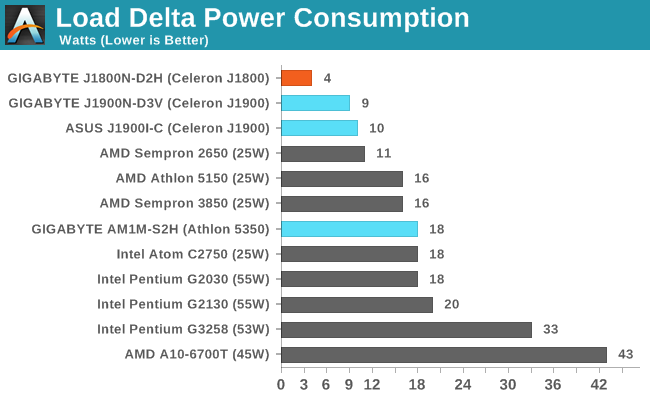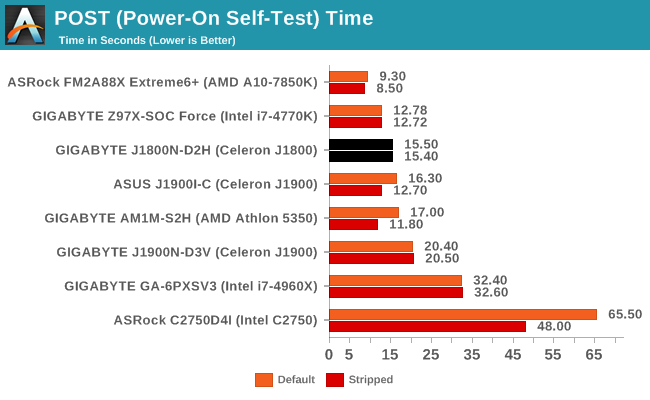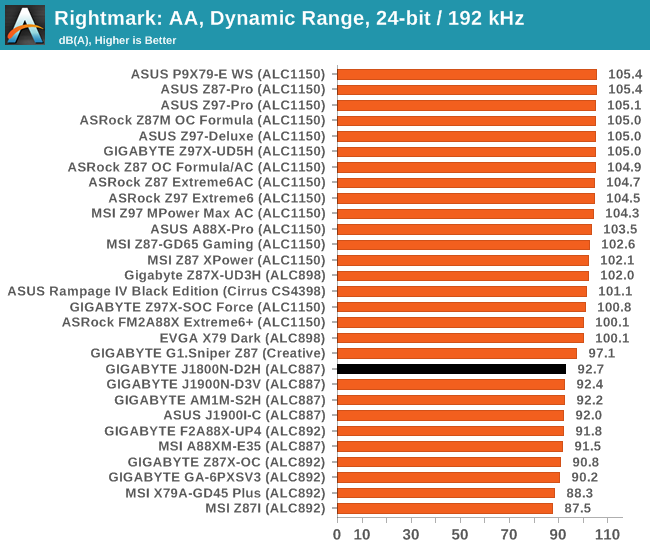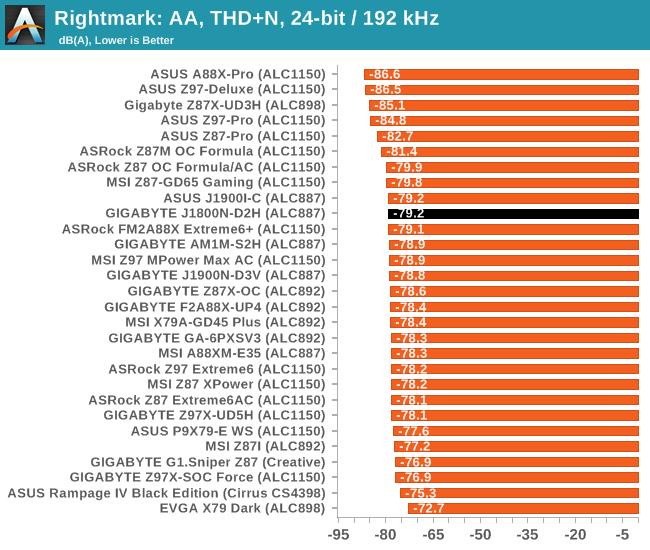GIGABYTE GA-J1800N-D2H Review: Dual Core Bay Trail-D at $69
by Ian Cutress on December 26, 2014 11:00 AM EST- Posted in
- Motherboards
- Intel
- Bay Trail
System and Motherboard Performance
Power Consumption
Power consumption was tested on the system while with a wall meter connected to the Rosewill 500W Platinum power supply. As this power supply is Platinum rated and as I am in the UK on a 230-240 V supply, this leads to ~75% efficiency > 20W, and 92%+ efficiency at 50W, suitable for both idle and multi-GPU loading. This method of power reading allows us to compare the power management of the UEFI and the board to supply components with power under load, and includes typical PSU losses due to efficiency. These are the real world values that consumers may expect from a typical system (minus the monitor) using this motherboard.
While this method for power measurement may not be ideal, and you feel these numbers are not representative due to the high wattage power supply being used, the important point to take away is the relationship between the numbers. These boards are all under the same conditions, and thus the differences between them should be easy to spot.

Despite being rated for a 10W TDP, the J1800 measures only 4W difference between idle and load. The J1900 is also rated at 10W TDP, but gives 9W/10W due to the extra cores.
Windows 7 POST Time
Different motherboards have different POST sequences before an operating system is initialized. A lot of this is dependent on the board itself, and POST boot time is determined by the controllers on board (and the sequence of how those extras are organized). As part of our testing, we look at the POST Boot Time using a stopwatch. This is the time from pressing the ON button on the computer to when Windows 7 starts loading. (We discount Windows loading as it is highly variable given Windows specific features.)

Out of the Bay Trail-D boards tested so far, the J1800N-D3H comes top for default POST times.
Rightmark Audio Analyzer 6.2.5
Rightmark:AA indicates how well the sound system is built and isolated from electrical interference (either internally or externally). For this test we connect the Line Out to the Line In using a short six inch 3.5mm to 3.5mm high-quality jack, turn the OS speaker volume to 100%, and run the Rightmark default test suite at 192 kHz, 24-bit. The OS is tuned to 192 kHz/24-bit input and output, and the Line-In volume is adjusted until we have the best RMAA value in the mini-pretest. We look specifically at the Dynamic Range of the audio codec used on board, as well as the Total Harmonic Distortion + Noise.


With all the motherboards in this test using the ALC887, there is not much to choose between them.
USB Backup
For this benchmark, we transfer a set size of files from the SSD to the USB drive using DiskBench, which monitors the time taken to transfer. The files transferred are a 1.52 GB set of 2867 files across 320 folders – 95% of these files are small typical website files, and the rest (90% of the size) are small 30 second HD videos. In an update to pre-Z87 testing, we also run MaxCPU to load up one of the threads during the test which improves general performance up to 15% by causing all the internal pathways to run at full speed.

Compared to the high end motherboards that perform our USB 2.0 tests around 42 seconds, the Bay Trail IO is relatively slow.
DPC Latency
Deferred Procedure Call latency is a way in which Windows handles interrupt servicing. In order to wait for a processor to acknowledge the request, the system will queue all interrupt requests by priority. Critical interrupts will be handled as soon as possible, whereas lesser priority requests such as audio will be further down the line. If the audio device requires data, it will have to wait until the request is processed before the buffer is filled.
If the device drivers of higher priority components in a system are poorly implemented, this can cause delays in request scheduling and process time. This can lead to an empty audio buffer and characteristic audible pauses, pops and clicks. The DPC latency checker measures how much time is taken processing DPCs from driver invocation. The lower the value will result in better audio transfer at smaller buffer sizes. Results are measured in microseconds.

Despite being motherboards with low power CPUs, the DPC latency is around the 100 microsecond mark which is a good sign.










38 Comments
View All Comments
trivor - Friday, December 26, 2014 - link
If all you need is a basic laptop for e-mail, web surf, light office docs (MS Office is actually too much program for this setup and I find myself using Kingsoft Office at home (even on my high powered machines) because it does all I need and is very lightweight. This would work very well on a Stream 11, 13, or 14 to do light office work - word processing, spreadsheet, or presentation. It saves in XML form - docx, xlxs, and pptx. The 11 especially is lightweight less than 3 lbs and adding a 64 or 128 USB stick or SD card would give plenty of extra storage over the 32 GB eMMC. You need to appreciate these products for what they are - Chromebook Competition. I think they will work quite well for younger kids or for a light laptop for around the house or even a work laptop (if work doesn't buy one for you) for short trips. I'm sure it would do fine on the movie front with Netflix or a nice 1 TB external drive with a movie and music collection.Kneedragger - Friday, December 26, 2014 - link
Did you guys test the NIC at all? I bought this mobo when it came out and from the beginning had a problem moving files over my network. It would fall flat on it ass and crash when trying to stream a Blu-ray rip or move a large file over my network. I was running Win 8.1 and tried everything. I ended up buying a Asrock Q1900 itx using the same RAM and OS the problem was gone.almostold2 - Friday, December 26, 2014 - link
" I thought it best to polish of the data and see if it still relevant alongside the $200 offerings and worth the potential extra cost for a full build to fill out a motherboard in exchange for the potential extra functionality (2T2R WiFi rather than 1T1R, SATA drives rather than eMMC)."Proofread please.
KaarlisK - Saturday, December 27, 2014 - link
"with the upper flipped around due to the dual channel nature of the SoC"Could Ian please elaborate on this?
Pissedoffyouth - Saturday, December 27, 2014 - link
OP can't inb4zodiacfml - Saturday, December 27, 2014 - link
I don't know what to do with this. Before, I built two desktops based on first and 2nd Gen Atoms as cheapest new desktop systems. For home use and applications, buying a cheap laptop would be better for many scenarios.As a firewall/router maybe with a separate purchase of a NIC but then you could buy a powerful home WiFi router and install DD-WRT.
As advertisement display maybe but I would prefer implementing wireless HDMI adapters since this mini-itx would require routing of lan and power cables.
yannigr2 - Saturday, December 27, 2014 - link
A useless product with an Intel logo on it making all the difference. Remove the Intel logo, and no one will care about it.PrinceGaz - Saturday, December 27, 2014 - link
PS/2 keyboard & mouse sockets? Are these still needed? Do people still use them? I'd rather have some more USB. Don't know if the chipset supports any more, but if not then they could always include an onboard hub from one of the existing USB2 to provide two or three more USB2 for low-bandwidth things like... a keyboard, a mouse, a printer, the lead to charge your phone and transfer data, all of which could co-exist in the available bandwidth from a single USB2 connection, so the others are free for more demanding stuff.PrinceGaz - Saturday, December 27, 2014 - link
Oh, and that Logitech MK120 you suggest requires two USB ports, one for the keyboard, one for the mouse. :pOxford Guy - Saturday, December 27, 2014 - link
People still use the old IBM M keyboards.